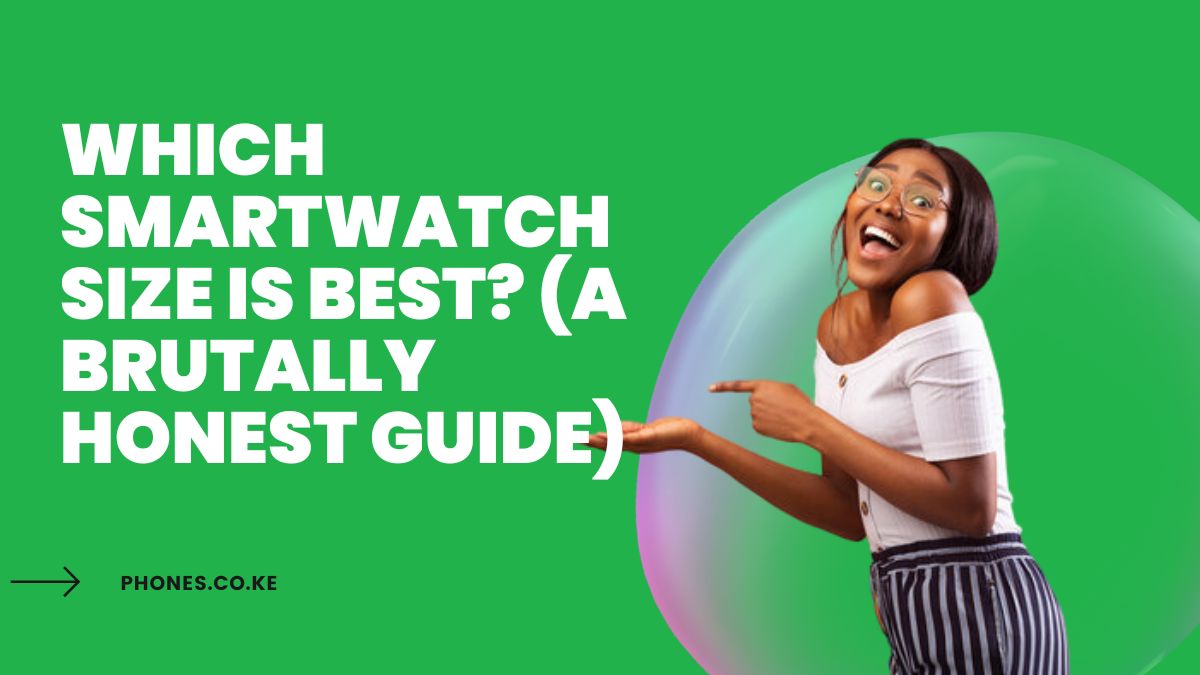Which Smartwatch Size Is Best? (A Honest Guide) Leave a comment
You’re here because you want a smartwatch, but you’re drowning in a sea of sizes. 38mm? 42mm? 45mm?
What the hell does it all mean?
Forget the tech jargon and confusing charts.
I’m going to give it to you straight, just like I would to a client in my office. By the end of this article, you’ll know exactly which smartwatch size is perfect for YOU.
This isn’t about fashion, it’s about function. A smartwatch is an investment, and like any investment, you need to make sure it’s the right fit.
Literally.
Smartwatch sizes
Smartwatches are available in a variety of sizes to accommodate different wrist dimensions and personal preferences. Here’s an overview of common smartwatch sizes and considerations for choosing the right one.
Common Smartwatch Sizes
General Size Categories
- Small (S): 41mm and smaller; suitable for wrist circumferences of 13 to 15 cm.
- Average (M): 42mm to 44mm; fits wrists measuring 15 to 17 cm.
- Large (L): 45mm to 48mm; designed for wrists between 17 to 19 cm.
- Extra Large (XL): 49mm and larger; appropriate for wrist circumferences of 19 to 22 cm[2].
Brand-Specific Sizes
Apple Watch:
- Series 9, 8, and 7: Available in 41mm and 45mm.
- Apple Watch SE (2022/2023): Offered in 40mm and 44mm.
- Apple Watch Ultra: The largest model at 49mm.
Samsung Galaxy Watch:
- Galaxy Watch6: Available in 44mm and 40mm.
- Galaxy Watch5: Comes in 44mm and 40mm.
- Galaxy Watch4 Classic: Offered in 42mm and 46mm.
Why Size Matters (More Than You Think)
Think of your wrist like real estate.
You’ve got a limited amount of space, and you need to use it wisely.
A smartwatch that’s too big? It’ll look like you strapped a tablet to your arm.
Too small?
You’ll be squinting to read your notifications.
Here’s the deal:
- Comfort: A watch that fits well is a watch you’ll actually wear. If it’s digging into your wrist or sliding around, it’ll end up in a drawer.
- Usability: The size of the screen directly impacts how easy it is to use your smartwatch. Navigating menus, reading messages, and tracking your fitness data all become a pain in the ass if the screen is too small.
- Aesthetics: Let’s be real, looks matter. You want a smartwatch that complements your style, not one that screams “I don’t know what I’m doing.”
Don’t fall for the “bigger is better” trap.
Just because a watch has a massive screen doesn’t mean it’s the best choice for you. It’s like buying a Hummer when all you need is a sedan. Sure, it’s impressive, but is it practical?
Here’s a quick hit list of what to consider:
- Wrist size: This is the most obvious factor. Measure your wrist circumference to get a baseline.
- Hand size: Got big hands? You might need a larger watch to maintain proportion.
- Personal preference: Some people like a chunky watch, others prefer something more subtle. There’s no right or wrong answer.
Bottom line: Choosing the right size is crucial. It affects everything from comfort to functionality to how you look.
Don’t screw this up.
Finding Your Goldilocks Size (Not Too Big, Not Too Small)
Alright, enough theory.
Let’s get down to brass tacks.
How do you actually figure out which size is right for you?
Step 1: Measure Your Wrist
Grab a flexible measuring tape (or a piece of string and a ruler).
Wrap it around your wrist, just above your wrist bone.
That’s your wrist circumference.
Write it down.
Step 2: Consider Your Hand Size
Look at your hand.
Is it relatively large or small compared to your wrist?
This will give you an idea of how a watch will look on your arm.
Step 3: Consult the Size Chart (But Don’t Obsess Over It)
Most smartwatch brands have size charts that recommend sizes based on wrist circumference.
Use these as a general guideline, but don’t treat them as gospel.
Here’s a rough idea:
- Small wrists (under 6 inches): Stick to smaller watches (38mm-40mm).
- Medium wrists (6-7 inches): You’ve got more options (40mm-44mm).
- Large wrists (over 7 inches): Go for larger sizes (44mm+).
Step 4: Try Before You Buy (If Possible)
The best way to know for sure is to try on different sizes.
Head to a store and see how they look and feel on your wrist.
Pay attention to how the watch sits on your wrist and how easy it is to use the buttons and touchscreen.
Pro Tip: If you’re buying online, check the return policy. You don’t want to be stuck with a watch that doesn’t fit.
Remember: It’s not just about the numbers. It’s about how the watch looks and feels on YOUR wrist.
Other Factors to Consider
You’ve measured your wrist, you’ve consulted the size chart, you’ve even tried on a few watches.
But there’s more to the story.
Here are a few other factors to keep in mind:
- Watch Style: Some smartwatches are bulkier than others. Consider the overall design and how it will fit with your style.
- Band Size: Make sure the band is adjustable and fits comfortably. A band that’s too tight or too loose can ruin the whole experience.
- Features: Do you need a large screen for detailed fitness data? Or is a smaller screen sufficient for basic notifications?
- Activity Level: If you’re active, you might want a smaller, lighter watch that won’t get in the way.
Here’s the thing:
A smartwatch is an extension of your phone. It should make your life easier, not more complicated. Choose a size that allows you to use all the features you need without feeling like you’re wearing a brick on your wrist.
Top Tools:
- Measuring tape: To measure your wrist circumference.
- Online size charts: To get a general idea of which size is right for you.
Don’t overthink it. Trust your gut. If a watch feels right, it probably is.
Getting the Most Out of Your Watch
You’ve nailed the sizing.
Now it’s time to make sure you’re getting the most out of your smartwatch.
Here’s how:
- Customize the watch face: Choose a watch face that displays the information you need most.
- Master the notifications: Filter your notifications so you only see what’s important.
- Explore the apps: There are tons of apps available for smartwatches. Find the ones that fit your lifestyle.
- Track your fitness: Use your smartwatch to track your steps, heart rate, and other fitness data.
- Use it as a tool: Set reminders, control your music, and even make payments with your smartwatch.
Here’s the key takeaway:
A smartwatch is more than just a watch.
It’s a powerful tool that can help you stay connected, organized, and motivated.
But only if you use it right.
Don’t let your smartwatch gather dust.
Experiment with different features and find ways to integrate it into your daily routine.
Top Tools:
- Your smartwatch’s app store: To find new apps and customize your watch.
- Online tutorials: To learn how to use all the features of your smartwatch.
The bottom line?
Get your money’s worth.
Use your smartwatch to its full potential.
Read also:



